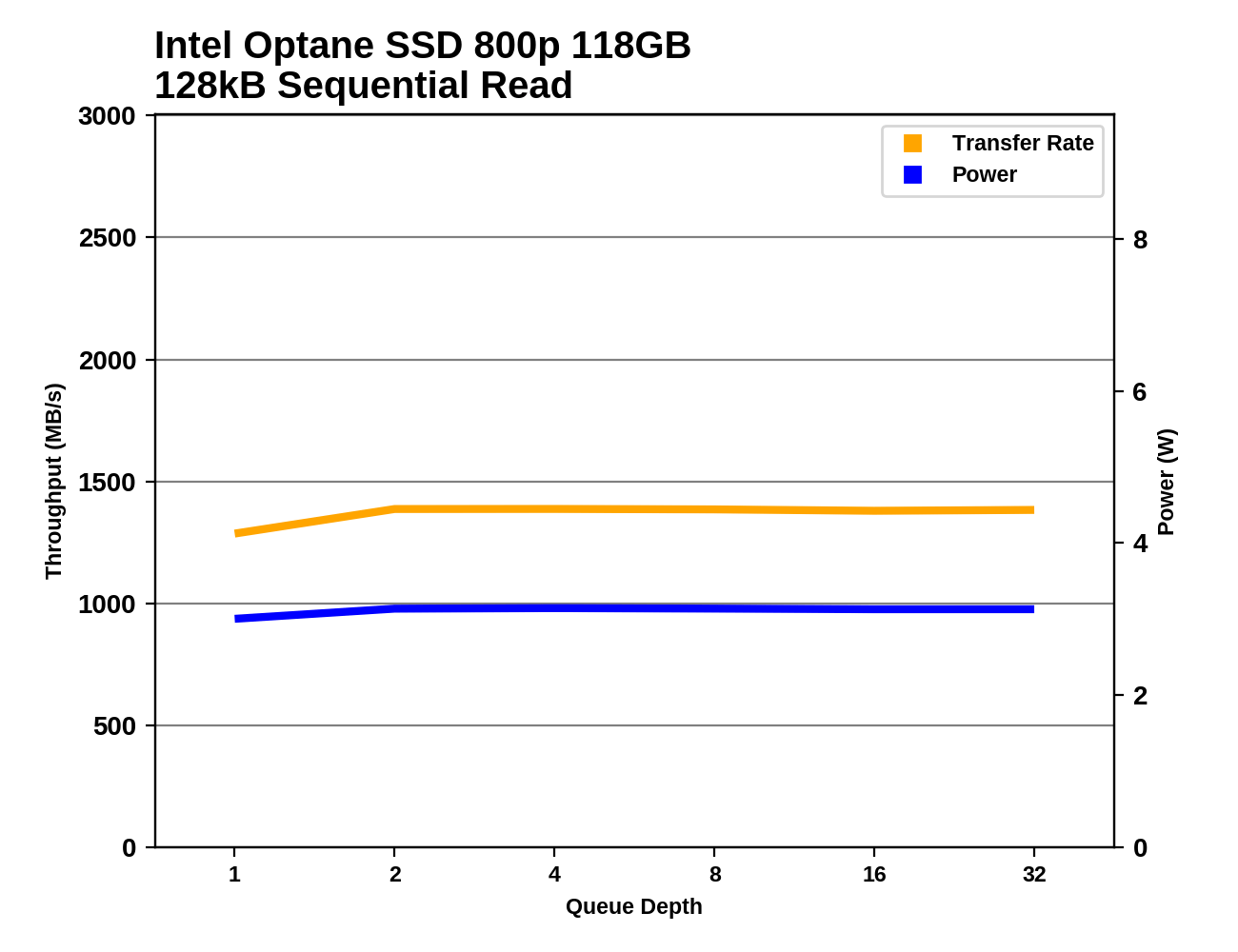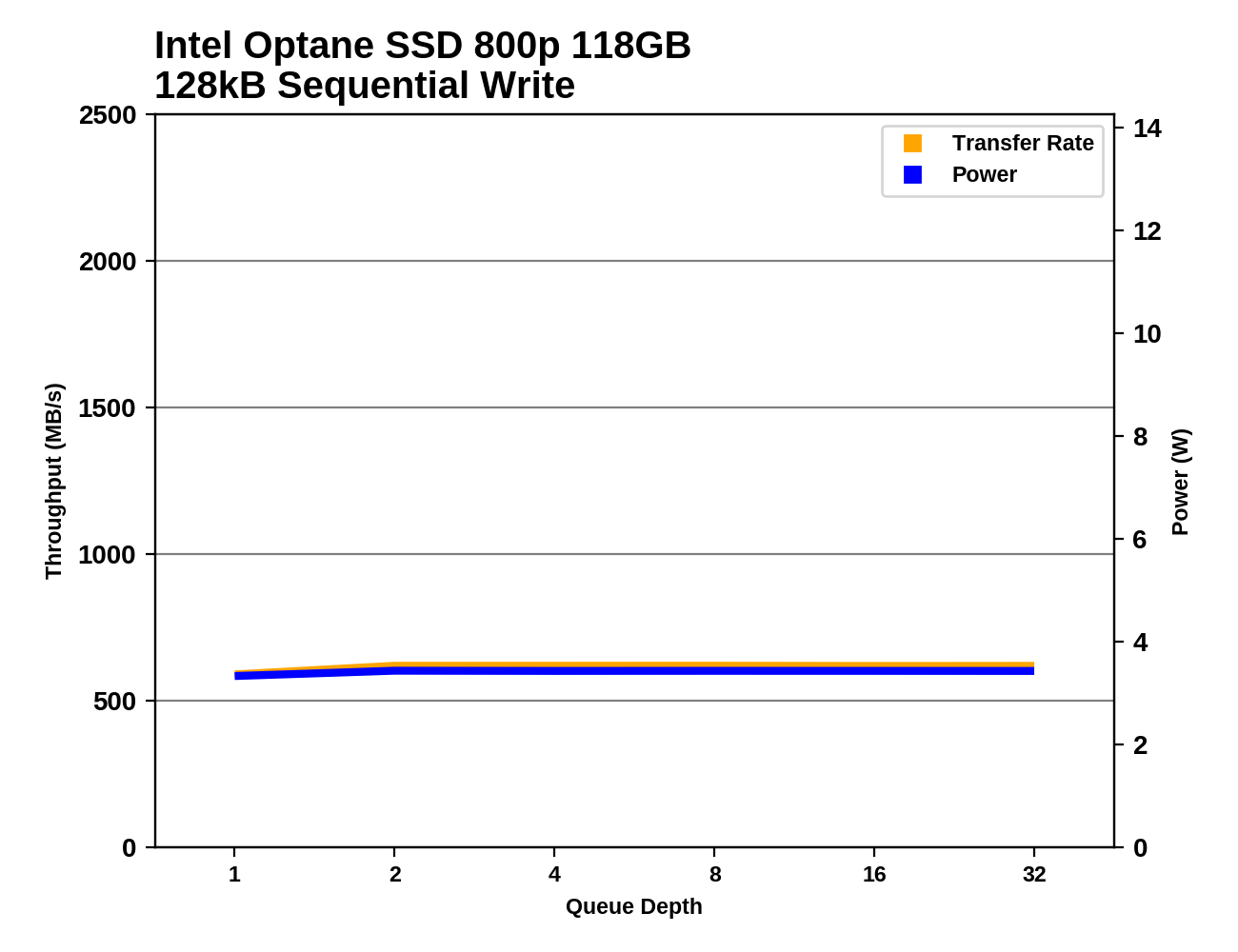The Intel Optane SSD 800p (58GB & 118GB) Review: Almost The Right Size
by Billy Tallis on March 8, 2018 5:15 PM ESTSequential Read Performance
Our first test of sequential read performance uses short bursts of 128MB, issued as 128kB operations with no queuing. The test averages performance across eight bursts for a total of 1GB of data transferred from a drive containing 16GB of data. Between each burst the drive is given enough idle time to keep the overall duty cycle at 20%.

The QD1 burst sequential read performance of the Intel Optane SSD 800p is close to their rated maximum throughput, but they are far behind the 900p and high-end Samsung drives that actually need more than two PCIe lanes.
Our test of sustained sequential reads uses queue depths from 1 to 32, with the performance and power scores computed as the average of QD1, QD2 and QD4. Each queue depth is tested for up to one minute or 32GB transferred, from a drive containing 64GB of data.

On the longer sequential read test, the Samsung NVMe SSDs fall down to the level of the Optane SSD 800p, because the flash-based SSDs are slowed down by some of the data fragmentation left over from the random write test. The Optane SSDs performed those writes as in-place modifications and thus didn't incur any fragmentation. This leaves the Samsung 960 PRO 2TB barely faster than the 800p, while the 900p runs away with its lead.

The Optane SSD 800p has the clear lead in power efficiency, as its second-tier performance comes with far lower power consumption than the top-performing 900p.
 |
|||||||||
There are no big surprises with the queue depth scaling; the 800p's sequential reads are slightly faster at QD2 than QD1, but there's no further improvement beyond that. The 800p is easily staying within its 3.75 W rated maximum power draw.
Sequential Write Performance
Our test of sequential write burst performance is structured identically to the sequential read burst performance test save for the direction of the data transfer. Each burst writes 128MB as 128kB operations issued at QD1, for a total of 1GB of data written to a drive containing 16GB of data.

The burst sequential write speed of the Intel Optane SSD 800p is no better than the low-end flash-based NVMe SSDs. Without any write caching mechanism in the controller, the fundamental nature of 3D XPoint write speeds shows through. The 900p overcomes this by using a 7-channel controller, but that design doesn't fit within the M.2 form factor.
Our test of sustained sequential writes is structured identically to our sustained sequential read test, save for the direction of the data transfers. Queue depths range from 1 to 32 and each queue depth is tested for up to one minute or 32GB, followed by up to one minute of idle time for the drive to cool off and perform garbage collection. The test is confined to a 64GB span of the drive.

The Optane SSD 800p looks better on the sustained sequential write test, as all the TLC-based SSDs run out of SLC cache and slow down dramatically, while the Optane SSDs keep delivering the exact same performance.

Despite their very different sequential write throughput, the Optane SSD 900p and 800p end up with very similar power efficiency on this test. The Samsung NVMe drives are even more efficient, but only the premium MLC-based 960 PRO has a large lead.
 |
|||||||||
Almost all of the drives show no performance scaling with increasing queue depth, as large-block sequential writes can keep all the memory channels busy with only a little bit of buffering. The 900p needs at least two 128kB writes in flight to reach full throughput.










116 Comments
View All Comments
0ldman79 - Thursday, March 8, 2018 - link
That is a pretty significant limitation.With SSD's a lot of us have small to mid sized SSD as a boot drive and practically everything else resides on a spinner.
If Optane can't cache the secondary drive then it is of less use to me than even the Kaby Lake and above limitation. That means that even if I built a Kaby Lake or Coffee Lake I still won't get any benefit on the anything aside from the OS. My games are all installed on a mechanical drive.
Lolimaster - Friday, March 9, 2018 - link
Crucial MX500 2TB $499If you're an avid GTAV player, the 118GB should be a nice thing for the game intall, also your pagefile and install/profile/cache of firefox/chrome.
TheWereCat - Friday, March 9, 2018 - link
Micron 1100 2TB $370https://www.amazon.com/gp/aw/s/ref=is_s_ss_i_1_9?k...
Reflex - Friday, March 9, 2018 - link
Yup, grabbed one of those a few weeks ago, its a great drive for that price.hescominsoon - Friday, March 9, 2018 - link
I run only a micro 1TB ssd in my machine for everything. I have a couple of friends who are into video editing and they use a spinning disk for temporary storage...but that's about it..:)name99 - Friday, March 9, 2018 - link
Any decent SSD that wants to boost itself with a cache can ALREADY do so by using some of the MLC or TLC flash as SLC. And thereby run faster than Optane. And without requiring a separate controller and a separate Optane die.Optane is not buying you anything in the sort of market you describe.
Gunbuster - Thursday, March 8, 2018 - link
Capacity is still useless for any power user who would be shopping this.iter - Thursday, March 8, 2018 - link
It will be useful for pagefile spillover in case you have workloads that require more than the 32 or 64 gb of ram that most high end desktops come with.It will still massacre performance if you go paging, but it will be significantly better than nand, god forbid hdd.
jospoortvliet - Friday, March 9, 2018 - link
That's an interesting use case, the first I read that seems reasonably useful... But it would still need more performance to really make it worth it, and even then only when you don't care about costs at all and your platform simply doesn't support more ram. I mean, as long as the system can handle another ram dimm, you'd go for that even with the insane prices atm...iter - Saturday, March 10, 2018 - link
The thing is many systems can't. 64 is currently a limit for high end, 128 for HEDT.It could get better by raiding more drives, but .... that's not an option on high end platforms due to the low PCIe lane count. You will have to give up on running a GPU if you want to snap in 4 of those drives.